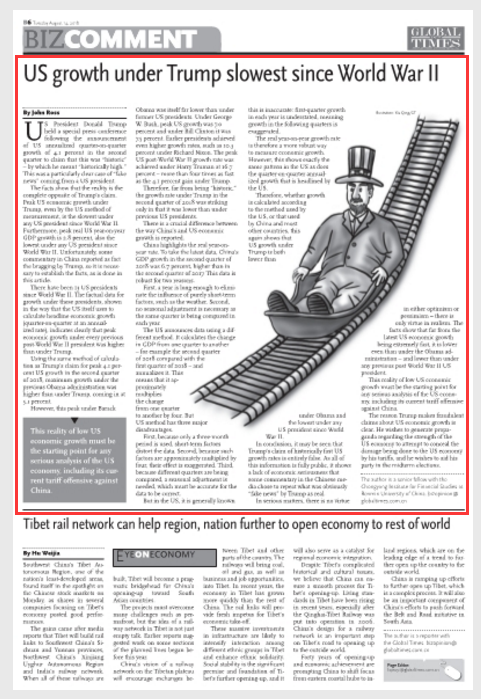Major Power Relations
Your Present Location: PROGRAMS> Major Power RelationsJohn Ross: US growth under Trump slowest since World War II
By John Ross Source: Global Times Published: 2018-8-13
US President Donald Trump held a special press conference following the announcement of US annualized quarter-on-quarter growth of 4.1 percent in the second quarter to claim that this was "historic" - by which he meant "historically high." This was a particularly clear case of "fake news" coming from a US president.

The facts show that the reality is the complete opposite of Trump's claim. Peak US economic growth under Trump, even by the US method of measurement, is the slowest under any US president since World War II. Furthermore, peak real US year-on-year GDP growth is 2.8 percent, also the lowest under any US president since World War II. Unfortunately, some commentary in China reported as fact the bragging by Trump, so it is necessary to establish the facts, as is done in this article.
There have been 13 US presidents since World War II. The factual data for growth under these presidents, shown in the way that the US itself uses to calculate headline economic growth (quarter-on-quarter at an annualized rate), indicates clearly that peak economic growth under every previous post-World War II president was higher than under Trump.
Using the same method of calculation as Trump's claim for peak 4.1 percent US growth in the second quarter of 2018, maximum growth under the previous Obama administration was higher than under Trump, coming in at 5.1 percent.
However, this peak under Barack Obama was itself far lower than under former US presidents. Under George W. Bush, peak US growth was 7.0 percent and under Bill Clinton it was 7.5 percent. Earlier presidents achieved even higher growth rates, such as 10.3 percent under Richard Nixon. The peak US post-World War II growth rate was achieved under Harry Truman at 16.7 percent - more than four times as fast as the 4.1 percent gain under Trump.
Therefore, far from being "historic," the growth rate under Trump in the second quarter of 2018 was striking only in that it was lower than under previous US presidents.
There is a crucial difference between the way China's and US economic growth is reported.
China highlights the real year-on-year rate. To take the latest data, China's GDP growth in the second quarter of 2018 was 6.7 percent, higher than in the second quarter of 2017. This data is robust for two reasons.
First, a year is long enough to eliminate the influence of purely short-term factors, such as the weather. Second, no seasonal adjustment is necessary as the same quarter is being compared in each year.
The US announces data using a different method. It calculates the change in GDP from one quarter to another - for example the second quarter of 2018 compared with the first quarter of 2018 - and annualizes it. This means that it approximately multiplies the change from one quarter to another by four. But US method has three major disadvantages.
First, because only a three-month period is used, short-term factors distort the data. Second, because such factors are approximately multiplied by four, their effect is exaggerated. Third, because different quarters are being compared, a seasonal adjustment is needed, which must be accurate for the data to be correct.
But in the US, it is generally known this is inaccurate: first-quarter growth in each year is understated, meaning growth in the following quarters is exaggerated.
The real year-on-year growth rate is therefore a more robust way to measure economic growth. However, this shows exactly the same pattern in the US as does the quarter-on-quarter annualized growth that is headlined by the US.
Therefore, whether growth is calculated according to the method used by the US, or that used by China and most other countries, this again shows that US growth under Trump is both lower than under Obama and the lowest under any US president since World War II.
In conclusion, it may be seen that Trump's claim of historically fast US growth rates is entirely false. As all of this information is fully public, it shows a lack of economic seriousness that some commentary in the Chinese media chose to repeat what was obviously "fake news" by Trump as real.
In serious matters, there is no virtue in either optimism or pessimism - there is only virtue in realism. The facts show that far from the latest US economic growth being extremely fast, it is lower even than under the Obama administration - and lower than under any previous post World War II US president.
This reality of low US economic growth must be the starting point for any serious analysis of the US economy, including its current tariff offensive against China.
The reason Trump makes fraudulent claims about US economic growth is clear. He wishes to generate propaganda regarding the strength of the US economy to attempt to conceal the damage being done to the US economy by his tariffs, and he wishes to aid his party in the midterm elections.
The author is a senior fellow with the Chongyang Institute for Financial Studies at Renmin University of China.























































































 京公网安备 11010802037854号
京公网安备 11010802037854号





